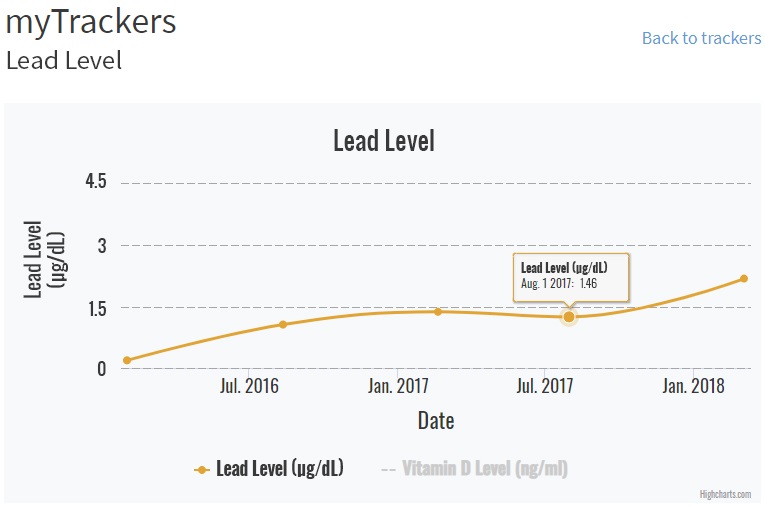Published on February 22, 2019
D*action Magnesium + Safety is a new project from GrassrootsHealth to provide you with information about your nutrient status for many essential elements and toxins. In previous blogs we discussed what magnesium is, why it’s important for health, and how magnesium status is assessed. We also previously discussed the other essential elements in the new testing panel (selenium, zinc, and copper) and the first heavy metal toxic element (cadmium). Today we will review the health effects of lead exposure, the second heavy metal toxic element in the new testing panel.
What is Lead?

Lead is a metal from the earth’s crust that can be found in small amounts in the soil, water, and air. It has been used in numerous products such as paint, pipes, gasoline, batteries, cosmetics, jewelry, and ammunition. Lead can enter the environment from these sources or from current and former industrial facilities, especially those involved in mining or producing lead. With the discontinuation of lead-based paint and leaded gasoline in most countries, exposure to the general public has significantly declined.
How are you exposed to Lead?
 Exposure to lead may occur by drinking water or eating food that contains lead. Using dishes or glasses that contain lead may also cause lead to be ingested. Lead can be inhaled, which is more readily absorbed by the body than when ingested. A common route for lead inhalation is during house construction projects in older homes if paint is disturbed or in buildings
Exposure to lead may occur by drinking water or eating food that contains lead. Using dishes or glasses that contain lead may also cause lead to be ingested. Lead can be inhaled, which is more readily absorbed by the body than when ingested. A common route for lead inhalation is during house construction projects in older homes if paint is disturbed or in buildings
where lead-based paint is deteriorating. Additionally, working or participating in hobbies where lead is used, such as construction, lead glass making, soldering, or scrap metal recycling increase the risk of exposure. Lead is particularly harmful to children because they absorb more lead than adults and their bodies are more vulnerable to its effects. Also, children may have increased exposure because they are more likely to put their hands, toys, and dirt in their mouths. Multiple government agencies, such as the Environmental Protection Agency (EPA) and the Food and Drug Administration (FDA) develop and enforce regulations regarding lead in drinking water and consumer products. It is important to only buy and use regulated products.
What are the potential health effects of Lead?
 Lead can accumulate in our bodies and is stored in bone, blood, and tissues. Over time, low-level lead exposure can affect the body’s cardiovascular, reproductive, and renal systems. Exposure can also reduce vitamin D and hemoglobin synthesis. Short-term exposure to very high levels can cause abdominal pain, headaches, loss of appetite, weakness, and memory loss. During pregnancy, lead in bones can be released and passed from the mother’s body to the baby which may result in miscarriage, premature birth, low birth weight, learning or behavioral problems, or damage to the baby’s brain, kidneys, or nervous system. In children, even low levels of lead in the blood can cause anemia, loss of hearing, lower IQ, hyperactivity, and behavior and learning problems. Rarely, high levels of lead exposure in children can result in severe neurological defects, coma, or death.
Lead can accumulate in our bodies and is stored in bone, blood, and tissues. Over time, low-level lead exposure can affect the body’s cardiovascular, reproductive, and renal systems. Exposure can also reduce vitamin D and hemoglobin synthesis. Short-term exposure to very high levels can cause abdominal pain, headaches, loss of appetite, weakness, and memory loss. During pregnancy, lead in bones can be released and passed from the mother’s body to the baby which may result in miscarriage, premature birth, low birth weight, learning or behavioral problems, or damage to the baby’s brain, kidneys, or nervous system. In children, even low levels of lead in the blood can cause anemia, loss of hearing, lower IQ, hyperactivity, and behavior and learning problems. Rarely, high levels of lead exposure in children can result in severe neurological defects, coma, or death.
How is Lead measured in the blood?
Lead is taken up by red blood cells and binds to hemoglobin, the protein that transports oxygen in the blood. Lead status can be assessed with a dried blood spot test. No safe lead blood level has been identified. The range of the average population the lab serves (reference range) is less than 2.23 micrograms per liter (μg/L).
Order your D*action Magnesium + Safety test TODAY! — includes Lead test
How can I track my Lead blood levels?
To help you track your toxin levels, GrassrootsHealth has created an online tracking system called myData-myAnswers. This will help you know how your toxin levels impact your health. Check it out today!








